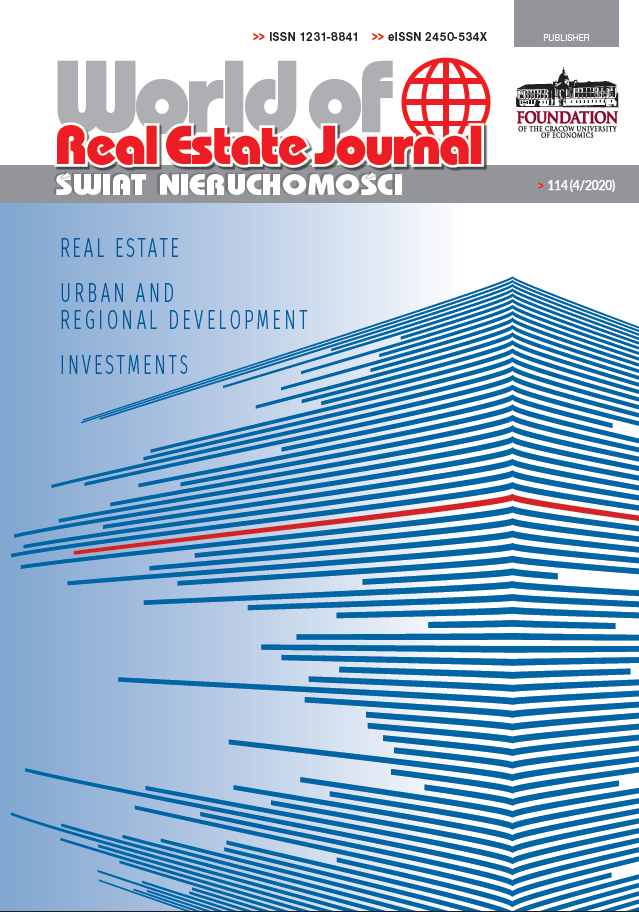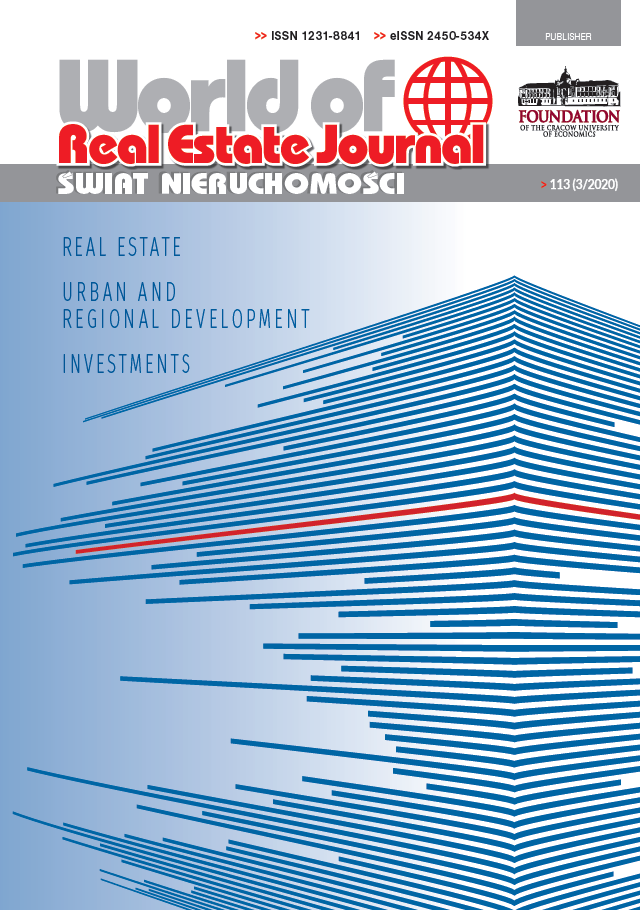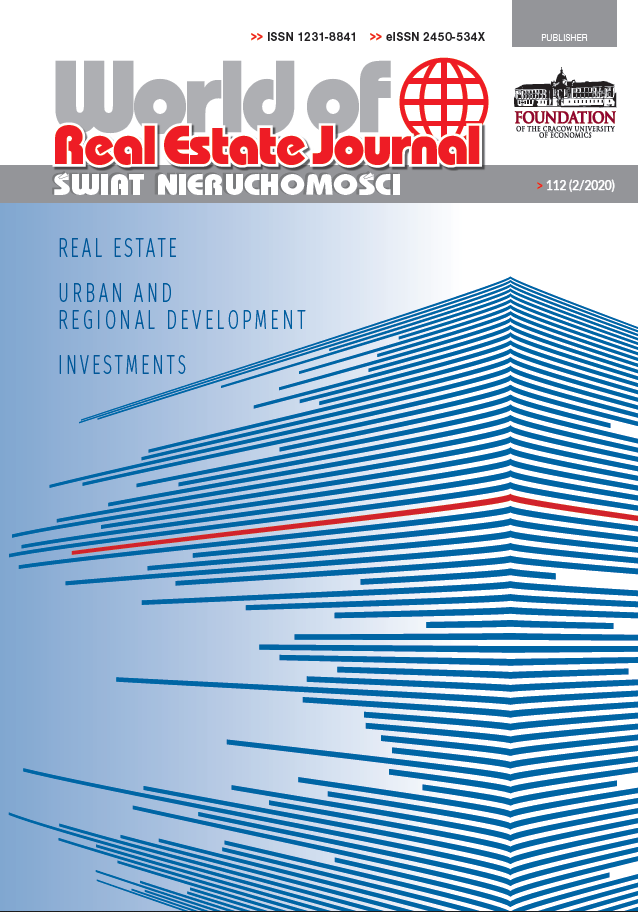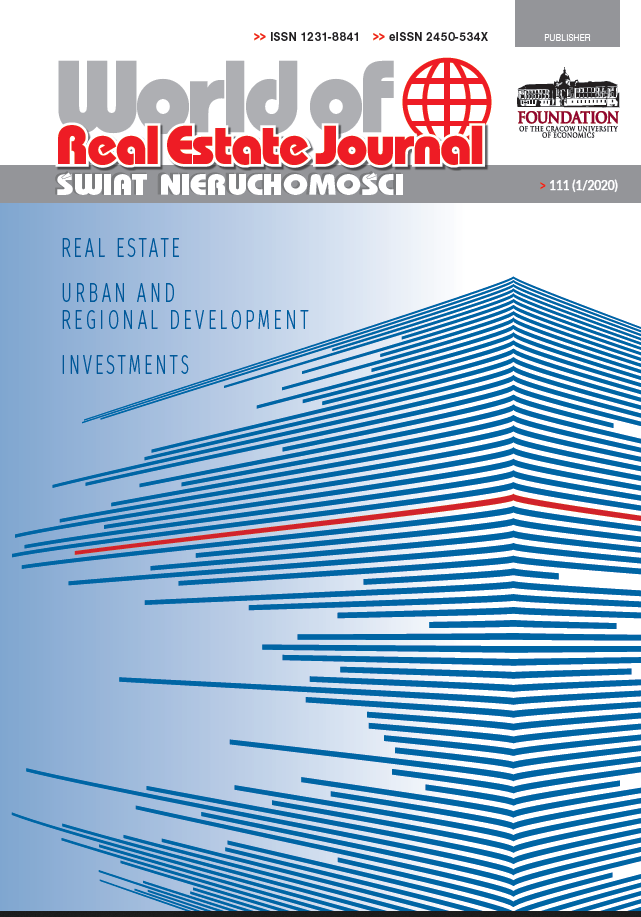MARKET
1. Anna Barańska, Sebastian Szkólik - The Old Town and Old Podgórze Districts in Krakow: Similarities and Differences in the Housing Markets Over a 4-Year Study Period
2. Janusz Jeżak, Anna Jędrzejko Maciej W. Wierzchowski, - Taxonomical Analysis of the economic development in the polish airport catchment areas
HOUSING
3. Daniela Špirková – The Economic aspects of the residential market development in the post crisis period in Slovakia
4. Petko Monev – The housing environment and the housing policy in Bulgaria in the context of sustainable development
REVITALIZATION
5. Wojciech Drozd – Building works in historical real estates
6. Koloman Ivanička, Daniela Špirková – Brownfield regeneration in Slovakia
FINANCES
7. Stanisław Belniak - Covered Bonds as a Source of Financing Residential Properties in Poland
8. Michał Głuszak, Bartłomiej Marona, Paweł Oleksy - Non-Fiscal Incentives and Challenges of Property Tax Reform in Poland
IN MEMORIAM
9. Daniela Špirková – Obituary - Professor Kolomana Ivanička
CONFERENCES
10. Andrzej Jaki - 18th International Scientific Conference "Restructuring of Enterprises and Economies in the Conditions of Global Market Development" (Krynica-Zdrój, 16th - 19th October 2013) DOWNLOAD
11. Joanna Węgrzyn - International Scientific Conference “Investments in tangible and financial assets” (Ustroń, 21th -23th October 2013) DOWNLOAD
WORLD OF REAL ESTATE JOURNAL 2013
12. Table of Contents 2013 DOWNLOAD
LIST OF REVIEWERS
13. List of Reviewers 2012 DOWNLOAD
SUMMARIES
Anna Barańska, Sebastian Szkólik - The Old Town District versus the Old Podgórze District in Krakow – Similarities and Differences of the Residential Real Estate Markets within the Period of 4 Years
The aim of this paper was to characterize and compare real estate markets in two districts of the city of Krakow: the Old Town and Old Podgórze. The study was based on numerous databases of the real estate properties which were created for these two districts on the basis of the records from the property price registers, land and mortgage registers, cadastral maps and field surveys. Having applied methods of statistical analysis (correlation and regression model, as well as various graphs and diagrams), the Authors selected the features of real estate which, to the greatest degree, decided about its price. The outcomes of the conducted studies allow us to determine what motivated the buyers to purchase properties in given districts, as well as which features they paid attention to and how this influenced prices of the real estate in a given market.
Key words: the analysis of real estate market; statistical methods; analysis of correlation; analysis of regression; scatter diagrams; histograms
Citation (APA): Barańska, A., Szkólik, S. (2013). The Old Town District versus the Old Podgórze District in Krakow – Similarities and Differences of the Residential Real Estate Markets within the Period of 4 Years.
Świat Nieruchomości, (4(86)), 6-15.
DOI: 10.14659/worej.2013.86.01
READ ALLJanusz Jeżak, Anna Jędrzejko - Taxonomical Analysis of the Economic Development in Polish Airport Catchment Areas
The article contains an outline of taxonomical analysis of the economic development in Polish civilian airport catchment areas. Individual features defined in the course of the research characterize the economic condition and the spatial developmental state of individual airport catchment areas. Descriptive statistics set for particular airport classes form a kind of indicators, reference points or benchmarks used in the course of the analysis and the assessment of status quo. They can be used later on in some processes, such as:
- choosing a set of supranational, standard tools for modeling the local spatial planning policy and creating integrated polycentric regional plans, and
- creating a development strategy of the airport catchment areas in Central Europe, basing on the historical development analogy method (considered with relation to an increase in GDP, improvement of the economic condition of households, etc.).
Key words: airport catchment areas; economical characteristics; land characteristics; classification airports; statistical measures – benchmarks
Citation (APA): Jeżak, J., Jędrzejko, A., Wierzchowski, M.W. (2013). Taxonomical Analysis of the Economic Development in Polish Airport Catchment Areas.
Świat Nieruchomości, (4(86)), 16-23.
DOI: 10.14659/worej.2013.86.02
READ ALLDaniela Špirková - The Economic Aspects of the Residential Market Development in the Post Crisis Period in Slovakia
The world economic crisis distinctly influenced also the real estate market in Slovakia. Since 2009 developer projects of all types have stagnated. But it is necessary to say that the residential real estate market is much more sensitive to negative turbulences on financial markets, as they have impact not only on developers but mainly on the income of households which are already repaying mortgages or they are interested in obtaining a housing via building credits or mortgages. Since the second half of 2010, the real estate market has started to revive slowly, and the market is slowly cleaned of older and often also problematic projects. According to a survey of Colliers International, all national economics in the region of Central and Eastern Europe, including Slovakia, are getting stable. Investors are searching for new opportunities in Slovakia. They are mainly interested in well rented office buildings in Bratislava and supermarkets in the regions. It stimulates positive development in the whole real estate market. Professionals estimate a long term increasing profit from rent and an increase in the priority of green buildings with economic activity. The article is focused on the current situation in the residential market in the Slovak Republic from the point of view of price development, offer and demand, as well as from the point of view of the crisis impact on the Slovak bank sector.
Key words: residential market in Slovakia; post crisis period in Slovakia
Citation (APA): Špirková, D. (2013). The Economic Aspects of the Residential Market Development in the Post Crisis Period in Slovakia.
Świat Nieruchomości, (4(86)), 24-29.
DOI: 10.14659/worej.2013.86.03
READ ALLPetko Monev - The Housing Environment and the Housing Policy in Bulgaria in the Context of Sustainable Development
This study highlights the new manifestations and characteristics of the housing problem and its solving by developing and implementing a housing policy at the national and local level within the context of sustainable development.
Key words: housing problem; dwelling; housing environment; housing policy; sustainable development
Citation (APA): Monev, P. (2013). The Housing Environment and the Housing Policy in Bulgaria in the Context of Sustainable Development.
Świat Nieruchomości, (4(86)), 30-35.
DOI: 10.14659/worej.2013.86.04
READ ALLWojciech Drozd - Building Works in Historic Real Estates
The article presents issues related to conducting works in historic real estates. The first part shows the existing administrative procedures in the construction process associated with historic buildings. The second part introduces the types of works, historic buildings and grants that took place during construction works in historic buildings in Cracow in recent years. The article aims to discuss these issues.
Key words: construction works; historic real estates; historic buildings
Citation (APA): Drozd, W. (2013). Building Works in Historic Real Estates.
Świat Nieruchomości, (4(86)), 36-41.
DOI: 10.14659/worej.2013.86.05
READ ALLKoloman Ivanička, Daniela Špirková - Brownfield Regeneration in Slovakia
Brownfield regeneration represents a challenge for many post-communist countries, including Slovakia, which have their specifics compared to western developed countries. This challenge is only partially addressed by the public authorities in Slovakia. Investors prefer to develop greenfield areas (less risk and faster return on investments) although the situation is changing. For some investors the following attributes are attractive: abandoned production facilities or buildings, which are usually connected to the existing distribution network, higher density of the built area, access to the infrastructure, less complicated obtaining of construction permits. By regeneration of brownfields, the particular objectives are pursued, as follows: upgrade, and enhancement of land value, growing attractiveness of the locality and facilities for business, the removal of old environmental burdens, pursuing the goals of sustainable urban development. In spite of these difficulties, there are positive and very successful redevelopment projects realized, such as Eurovea in Bratislava.
Key words: requirements for brownfield regeneration; Brownfield extension
Citation (APA): Ivanička, K., Špirková, D. (2013). Brownfield Regeneration in Slovakia.
Świat Nieruchomości, (4(86)), 42-47.
DOI: 10.14659/worej.2013.86.06
READ ALLStanisław Belniak - Covered Bonds as a Source of Financing Residential Properties in Poland
The relatively small equity of mortgage banks that has been created in Poland over the last twelve years does not allow the refinancing of housing real estate credits with the use of mortgage bonds. Nonetheless, there is more imminent threat of liquidity problems among the universal banks that have granted mortgage loans for financing housing real estate. Thus, one expects to see the emergence of a system of issuing bonds to improve the financial standing of those banks. The process of the development of mortgage banking raising funds on capital markets through the issue of bonds has already commenced in Poland. The paper presents the essence and the legal groundwork for that process, as well as the volume and the structure of bonds issue against the background of refinancing mortgage loans with bonds in the selected countries of the European Union. The paper includes a discussion of security principles, and presents the main issuers of bonds. Due to the attractiveness of that financial instrument, the discussion includes the presentation of the bond market in Poland, and its main investors. In conclusion, the Author presents prerequisites for the encouragement and acceleration of the type of financing which will also increase the credibility of that security on the financial market.
Key words: Covered Bond; Source of Financing; Residential Properties; polish market
Citation (APA): Belniak, S. (2013). Covered Bonds as a Source of Financing Residential Properties in Poland.
Świat Nieruchomości, (4(86)), 48-53.
DOI: 10.14659/worej.2013.86.07
READ ALLMichał Głuszak, Bartłomiej Marona, Paweł Oleksy - Non-fiscal incentives and challenges of property tax reform in Poland
In the paper we discuss the significance of the research, with reference to the ongoing debate in Poland about the property tax system and its possible reform towards ad valorem model. We focus on two major non-fiscal issues: (i) economic and spatial efficiency, (ii) equity and fairness. Prior research identified several flaws of value-based property systems related to economic and spatial efficiency and equity and fairness of value based property tax system, nevertheless, we found that areabased property tax systems are also far from being optimal. We conclude that there is a considerable gap in economic research concerning area-based property tax systems.
Key words: property tax; ad valorem model; property tax reform; local government
Citation (APA): Głuszak, M., Marona, B., Oleksy, P. (2013). Non-fiscal incentives and challenges of property tax reform in Poland.
Świat Nieruchomości, (4(86)), 54-59.
DOI: 10.14659/worej.2013.86.08
READ ALL





















































